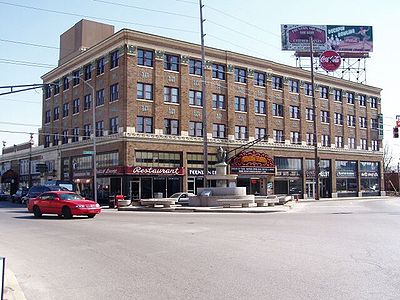
Fountain Square, Indianapolis
Encyclopedia

Indianapolis Cultural Districts
Indianapolis has six designated neighborhoods as Cultural Districts: Broad Ripple Village, Massachusetts Avenue, Fountain Square, the Wholesale District, the Canal & White River State Park, and Indiana Avenue.-Broad Ripple Village:...
in Indianapolis, Indiana
Indianapolis, Indiana
Indianapolis is the capital of the U.S. state of Indiana, and the county seat of Marion County, Indiana. As of the 2010 United States Census, the city's population is 839,489. It is by far Indiana's largest city and, as of the 2010 U.S...
.
History
In 1835, Calvin FletcherCalvin Fletcher
Calvin Fletcher was an attorney and legislator from Indianapolis, Indiana, USA.-Early life:Fletcher was born in Ludlow, Vermont to Jesse and Lucy Keyes Fletcher. He started out for Urbana, Ohio in 1817 where he studied law in Urbana under James Cooley and was admitted to the Ohio bar in 1820...
and Nicholas McCarty purchased a 264 acres (1.1 km²) farm in what would became the Fountain Square neighborhood. Although the earliest settlement was sparse and primarily residential, substantial settlement and rapid commercial growth occurred in the area beginning in the 1870s. Much of the development was fueled by a large number of German immigrants settling in the area. German and German-American merchants helped to establish much of the character in this neighborhood.
The Virginia Avenue corridor began to emerge as the South side's commercial center in the 1860s. When the Citizen's Street Railway Company laid tracks down Virginia Avenue and located a turnaround at the intersection of Virginia Avenue with Shelby and Prospect Streets in 1864, the neighborhood began to be known as "The End" by local residents.

G. C. Murphy Building
The G.C. Murphy Building, better known as "The Murphy" or "The Murphy Building" was built in 1884 and is located at 1043 Virginia Avenue in the historic Fountain Square District of Indianapolis, Indiana, USA. The G.C...
(1929), are examples of this phenomenon.
Fountain Square also played an important part in the Indianapolis theater heritage. The area had more operating theaters than could be found in any part of Indianapolis from 1910 to 1950. Fountain Square continued to fill the role of "downtown" for the south side well into the 1960s, offering multiple movie/vaudeville theaters, independent banks, a wide range of retail, and churches/social centers serving a range of ethnicities.
The 1950s witnessed the beginning of the economic decline as new developments further south eclipsed Fountain Square's long-standing role as the Southside's primary commercial center. The closing of all of the neighborhood's theaters provided an obvious example of Fountain Square's commercial decline. A symbolic example was the removal of Fountain Square's fountain to the Garfield Park Conservatory
Garfield Park Conservatory and Sunken Gardens
Garfield Park is a regional city park in Indianapolis, Indiana. Established in the late 19th century, it is the oldest city park in Indianapolis and is on the National Register of Historic Places. The park is located at the confluence of Pleasant Run and Bean Creeks on the near Southside of...
in 1954.
Between 1950 and 1970, neighborhood resident composition changed as the largely German, Irish, and Italian original residents moved further out. The construction of the interstate system in the 1970s led to the demolition of hundreds of homes and many businesses and churches, displacing residents and adding to the suburban flight that began in the 60s. This confluence of events triggered a 15-year period of decline.
The Fountain Square commercial area began to benefit from concentrated reinvestment in the late 1990s.
Today
Fountain Square is becoming better known as a home for unique restaurants, art galleries and studios, live entertainment, antiques, and small professional offices. Thanks to the efforts of Southeast Neighborhood Development, and projects like the Wheeler Arts Community and the Murphy Art CenterG. C. Murphy Building
The G.C. Murphy Building, better known as "The Murphy" or "The Murphy Building" was built in 1884 and is located at 1043 Virginia Avenue in the historic Fountain Square District of Indianapolis, Indiana, USA. The G.C...
, the area is developing as a primary live/work community for Indianapolis artists. The gradual transformation of the commercial district has attracted growing investment in surrounding residential areas, with both long-time residents and new homeowners participating in improving the quality of area homes. Neighborhood support services, such as the Fountain Square Branch http://www.imcpl.org/about/locations/fountainsquare.html of the Indianapolis-Marion County Public Library
Indianapolis-Marion County Public Library
The Indianapolis Public Library is the public library system that serves the citizens of Marion County, Indiana, United States and its largest city, Indianapolis...
, are becoming plentiful, and the area is becoming a home for organizations of all types.
Today the dance hall inside the building of the historic diner and bowling alley has been part of a revival of swing dancing.
Future
The designation of Fountain Square as one of Indiana's first urban Main Street programs, coupled with the distinction of being named as one of the six Indianapolis Cultural DistrictsIndianapolis Cultural Districts
Indianapolis has six designated neighborhoods as Cultural Districts: Broad Ripple Village, Massachusetts Avenue, Fountain Square, the Wholesale District, the Canal & White River State Park, and Indiana Avenue.-Broad Ripple Village:...
, has the commercial district poised for further reinvestment and improvement. Long-term projects are in the planning stages, including upgrades to the street scape and fountain, developing additional public space, and creating gateways and directional signs that visually define Fountain Square as one of the unique neighborhoods of Indianapolis.
External links
- Discover Fountain Square Cultural District
- Fountain Square Theater Building
- Historic Fountain Square Photo Essay
39°45′8"N 86°8′24"W

